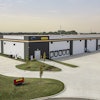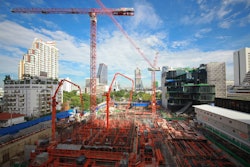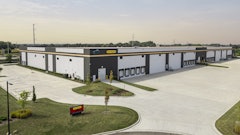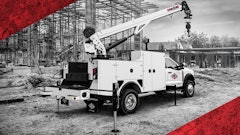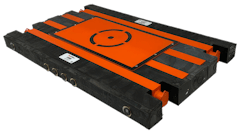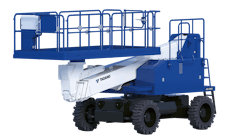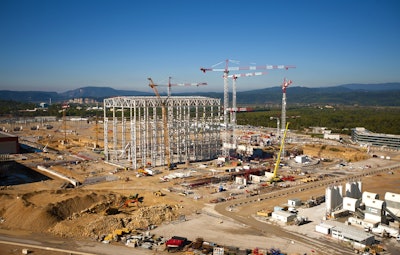
The challenge:
Lift and assemble over one million components for a first-of-its-kind experimental nuclear fusion facility in the South of France
The players:
Dodin Campenon Bernard
VFR Group
The process:
Potain tower cranes are building one of the world’s largest experimental nuclear fusion reactors at a huge site in the South of France. Built from stainless steel sections which have thicknesses ranging from 2 to 10 inches, the ITER fusion reactor will house the systems necessary for the operation of the ITER Tokamak device. The Tokamak complex is where the nuclear power will be generated. It consists of a seven-story concrete building measuring 394 feet long and 262 feet wide. There will be 17,636 tons of rebar, 5,297,200 cubic feet of concrete and 8,267 tons of steel in the structure.
The six Potain cranes working on the €300 million project include two topless tower cranes — an MDT 308 and an MDT 368 — and four traditional top-slewing tower cranes, the MD 610 M40, MD 485 B, MD 560 B and the MD 175. The cranes were supplied new to Dodin Campenon Bernard, a subsidiary of contracting giant Vinci Construction, which is managing all lifting work on site. Overall construction management is being handled by the VFR Group, a consortium made up of Vinci, Ferrovial and Razel Bec.
Laurent Moustraire, plant manager at Dodin Campenon Bernard, said the cranes are handling a succession of difficult lifts as components for the Tokamak are joined together. “For this extremely important job we needed to be certain that we were working with a professional and reliable crane provider,” he said. “Manitowoc was chosen because the team in charge of this specific project has been with us since the beginning of the tender. They fully understood the scope of what needs to be done and the constraints involved — so they were able to offer cranes specifically designed to meet our needs. Also, the presence of a Manitowoc Crane Care facility in the area was reassuring and an important factor in our final decision.”
Manitowoc’s Lift Solutions division, which provides specialist engineering support to customers, was closely involved in the crane planning and installation on the project. The structure’s unique design and complex construction process meant that a range of crane capacities were required.
Pascal Ducrot, director of Lift Solutions, said the cranes were selected not only for their capabilities but also for their proven reliability and performance on countless other jobsites. “Building an experimental facility, which is the first of its kind, obviously means that we are undertaking something which has never been done before,” he said. “Because of this, the contractor wanted to minimize the amount of unknown factors on the project, so it was important that the cranes had proven their capabilities in real world situations. This fusion facility is highly ambitious and the climate and sensitive working conditions will test the cranes — but we are confident in their capabilities and so is the customer.”
The cranes were delivered at the end of 2014 and are expected to be on the job for at least five years. Because of the complexity of the project, the erection of the cranes took six months to complete. All were mounted on large mast sections to ensure optimum lift capability.
The Potain cranes are currently working long shifts, handling the assembly of over one million components which will be used in the Tokamak device — and which are fabricated by suppliers from all around the world. Manitowoc has ensured that Crane Care service crews visit the jobsite regularly.
“Manitowoc had a cooperative and proactive approach to managing this project,” said Jean-Claude Guiter, key accounts director at Manitowoc. “Our client appreciated the ongoing communication we provided and, combined with our technical and service support, it gave them the confidence to select Potain cranes for this contract.”
The 13-ton capacity MDT 308 has been fitted with a 115-foot jib and is working at a height of 167 feet. For the MDT 368, which has a maximum capacity of 17 tons, jib length is 180 feet and working height is 266 feet
The MD 610 M40 is the largest crane on the project, it has a 44-ton maximum capacity, its jib is configured at 213 feet in length and it has been erected to a working height of 253 feet.
The MD 485 B has a maximum capacity of 22 tons, it is working with a 197-foot jib at a working height of 246 feet. For the 27-ton capacity MD 560 B, jib length is 180 feet and working height is 210 feet.
The MD 175 B has a maximum capacity of 8 tons, jib length is 115 feet and its working height is 92 feet.
The ITER project is designed to demonstrate the large-scale production of electrical power and the self-sufficiency of tritium fuel. Made up of 39 buildings covering an area of 42 hectares, the facility is set to be the world’s biggest energy research project.


